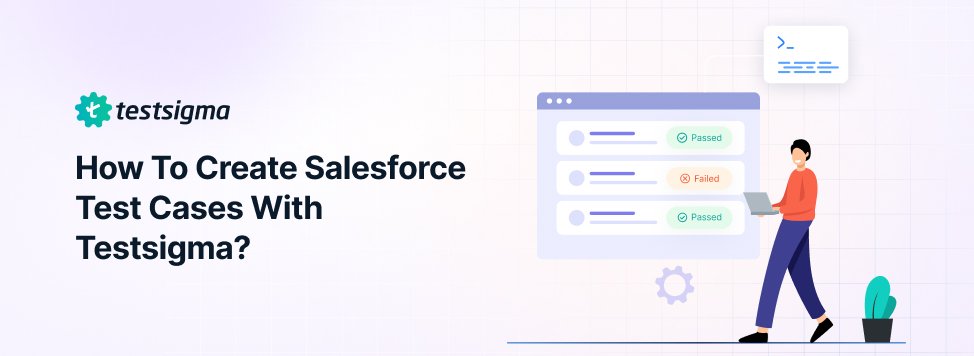How To Create Salesforce Test Cases With Testsigma
Introduction
Keeping the custom Salesforce application stable and functional is critical to any organization as they heavily rely on it for crucial business operations. And rigorous testing is the only way to ensure that the application is working as expected.
In this blog, we will discuss how to create Salesforce test cases using Testsigma to automate Salesforce testing, ensuring the application is functional and bug-free.
Testsigma - 10x Faster Codeless Test Automation Built For
Salesforce Testsigma is a no-code GenAI-powered test automation platform that allows testers to automate Salesforce testing without writing any code. So, how do you create tests without code scripts?
With Testsigma, you can create Salesforce test cases using plain English statements using Debug & Record or the NLP engine. Yes, it is as simple as that. All you have to do is connect your Salesforce instance with Testsigma.
Testsigma is a unified testing platform that supports web, mobile, desktop, API, and Salesforce testing in the same platform. You can automate the end-to-end of any application type using codeless testing powered by GenAI for faster and more efficient testing.
The next obvious question is, 'How do we create automated Salesforce test cases with Testsigma?'
How To Create Salesforce Tests Using Testsigma
You can quickly create reliable Salesforce test cases using Smart NLPs or Debug & Record. A quick overview of how to automate Salesforce tests using Testsigma,
Step 1: Create a free Testsigma account to access the cloud platform here: https://testsigma.com/signup
Step 2: Create a new project by navigating to Project -> New Project on the platform.
Step 3: Enter the project details and select Salesforce from the application type.
Step 4: You will now be directed to the Salesforce connections page, where you can securely connect Testsigma with your Salesforce instance using Salesforce Metadata and APIs.
Note: You can edit or refresh your Metadata connection later. Also, you can add users by using the User Connection prompt.
Step 5: Once the sync is complete, you can start creating test cases using Create Test Case. You can use the NLPs or Debug & Record to create test cases.
How to create Salesforce test cases with Testsigma
Step 6: Once test cases are created, execute them using the Run button.
Automated Salesforce testing with Testsigma
Note: You can easily manage Salesforce element repositories before or after test case creation.
What Makes Testsigma The Best Platform For Salesforce Testing?
Be agile and automate your entire testing lifecycle from development to production. With Testsigma, you can scale and enhance your Salesforce testing. How? Let's break down the key features,
No-code test creation: Create reliable Salesforce test cases using plain English statements.
Zero setup: Connect Testsigma with your Salesforce instance with just a few clicks using Salesforce Metadata and APIs.
Special NLPs: Testsigma supports special NLPs that are specific to Salesforce applications that help reduce test authoring time by 50%. These NLPs were precisely developed to address the challenges in Salesforce testing by leveraging Salesforce's synced Metadata.
Salesforce test automation
Error Handling: With Metadata refresh, the platform identifies the potential causes of the test failures due to Salesforce organization structure updates
Test across environments: Test across different Salesforce Developer Sandbox - Developer Pro, Partial Copy, and Full Sandbox
10x faster: Create and run automated tests 10x faster on the cloud infrastructure.
AI-driven maintenance: Auto-healing automatically adapts to any element changes whenever the application undergoes updates.
Parallel testing: Run multiple tests on various test environments for faster releases and shorter test cycles.
Real device cloud: Automate your tests across 3000+ real device/browser/OS combinations on the cloud.
Key Takeaways
Leverage Testsigma to:
1. Enhance and scale your Salesforce testing process from development to production.
2. Make Salesforce testing accessible to testers, developers, Salesforce platform managers, stakeholders, and everyone involved in the project using codeless automation.
3. Save time, effort, resources, and costs involved in testing.




